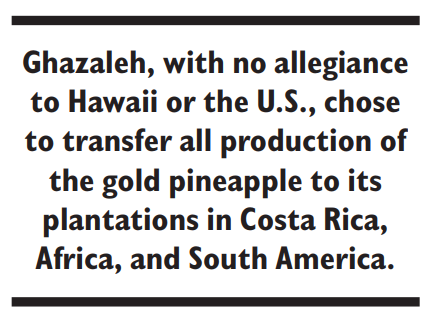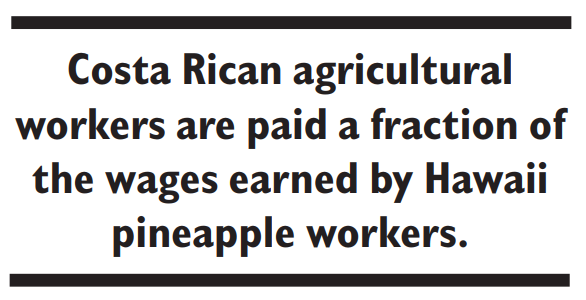A new company, the Haliimaile Pineapple Co., will continue to grow pineapple to supply the fresh, whole-fruit market and supply juice used by Tedeschi Vineyards to make its pineapple wine.
The new company has purchased some of Maui Pine’s equipment, leased 1,000 acres of land, and bought the rights to use the Maui Gold brand.
The company was formed by former Maui Pineapple Company executives, Ulupalakua Ranch owner Pardee Erdman, and other shareholders.
The company started operating on January 2, 2010, with 65 former Maui Pine workers. The company also negotiated a collective bargaining agreement with the ILWU.
Haliimaile Pineapple is already receiving orders for fresh pineapple from Maui hotels, Oahu, and the Mainland. If demand for their pineapple increases, the company may hire more workers.
The company plans to consolidate its operations in Haliimaile where it will pack, store and ship its pineapple.
Maui Pine Closure
After 97 years, the last harvest for Maui Pine, a subsidiary of Maui Land & Pineapple Co., was Dec. 23, 2009.
The company shocked its workers and the local community when it suddenly announced on November 3, 2009, that it would close all pineapple operations by the end of the year. There would be no attempt to harvest the ripening crop already planted on 3,000 acres. The company said it lost $115 million from its pineapple operations since 2002
The company would focus on its Kapalua Resort and real estate business which it operates as the Kapalua Land Company. Developments in the resort include: The Ritz-Carlton, Kapalua; The RitzCarlton Club and Residence; the Kapalua Spa; Kapalua Villas; The Plantation and The Bay Golf Courses; and the Honolua Store.
It has been a rough eight years for Maui Pine workers who are all ILWU members. They had to endure layoffs, relocations, job changes, and management decisions which sometimes made no sense.
It started with management plans to close the Kahului Cannery and move to a new packing plant at Haliimaile. Then the company decided to close Haliimaile plantation and move everything to Honolua. When that didn’t work out, the company decided to close Honolua and move back to Haliimaile.
Through it all, the workers did their best to keep the company going. Earlier this year, Maui Pine members agreed to a 10 percent wage cut to show their commitment to the survival of the company.
Pineapple war
Maui Pine’s sudden decision to quit pineapple may have been influenced by a September 30, 2009, federal court dismissal of an anti-trust lawsuit against Fresh Del Monte on September 30, 2009. The lawsuit filed in 2004, charged Fresh Del Monte with unfair trade practices in its sale of Del Monte Gold Extra Sweet pineapple.
Fresh Del Monte was flooding the U.S. market with the extra sweet pineapple grown in Costa Rica by workers earning $1 an hour. It was the same pineapple as Maui Gold and Dole’s Hawaii Gold.
The lawsuit claimed Fresh Del Monte claimed exclusive rights to the pineapple and threatened legal action against distributors and stores that sold Maui or Hawaii Gold pineapple. The judge dismissed the case saying there was insufficient evidence.
Joint MD-2 research ends in litigation
The new pineapple variety was a hybrid named MD-2 created after years of research by the Hawaii Pineapple Institute, which was jointly funded by Maui Pine, Dole, and Del Monte. The Institute shut down in 1986 and the assets were divided among the three companies.
Since 2000, the three companies have sued each other over the use of the MD-2 pineapple, trademark and patent infringement. All of these cases were dropped, dismissed, or settled out of court.
As a result, none of the companies have the exclusive right to MD-2, there is no patent on MD-2, and farmers all over the world are growing MD-2 pineapple.
Worldwide pineapple technology came from Hawaii
In 1996, Del Monte sold its fresh fruit division to a corporation controlled by the Abu-Ghazaleh family from Jordon. Del Monte was an American company with roots in California.
Mohammed Abu-Ghazaleh, chairman and CEO, incorporated Fresh Del Monte under the laws of the Caymen Islands, which makes it a foreign company.
Fresh Del Monte began selling the gold pineapple in 1996 which became an instant success with U.S. and European consumers.
At the time, Fresh Del Monte grew most of its gold pineapple in Hawaii and some on a plantation it owned in Costa Rica. Ghazaleh, with no allegiance to Hawaii or the U.S., chose to transfer all production of the gold pineapple to its plantations in Costa Rica, Africa, and South America. This was strictly a business decision to grow the pineapple closer to the markets in countries with lower labor costs.
Pineapple is grown by taking plant material from the crown, slips, or suckers of one crop to produce the next crop. From 1997 to 2001, Fresh Del Monte took almost half the plant material grown on its Oahu plantation to “seed” 22,000 acres in Costa Rica, 12,600 acres in Kenya, and 7,000 acres in Brazil. Oahu pineapple land was not replanted and the Del Monte plantation in Hawaii shrank from 9,600 acres in 1996 to 5,800 acres in 2001.
Del Monte members remember acres of seed being prepared to air ship to Costa Rica. Del Monte members were also flown to Costa Rica to repair and setup equipment and Costa Rican managers worked in Hawaii to learn the cultivation techniques.

It takes 18 months from seed to mature fruit so it would take 3-5 years before Costa Rica and Brazil reached full production of the new pineapple.
In February 2006, Fresh Del Monte announced it would close its Oahu plantation immediately, two years ahead of schedule. Over 700 ILWU Del Monte members lost their jobs.
Decline of Pineapple
At its peak in 1992, Maui Pine consisted of five ILWU units with 1,233 members: Honolua Plantation with 161 workers, the Container Operations with 54 members, the Cannery with 203 members, Haliimaile Plantation with 262 members, and 552 Intermittents, who were covered seasonals.
The company had high hopes for its Maui Gold pineapple, but Fresh Del Monte would shatter this dream.
Fresh Del Monte bought their own container ships to deliver the pineapple from Costa Rica to Del Monte owned distribution centers in the United States and Europe. Costa Rican agricultural workers are paid a fraction of the wages earned by Hawaii pineapple workers. This gives the company a huge cost advantage over Maui Pine and Dole, and Fresh Del Monte can price their pineapple lower and still make a good profit.
By 2007, the membership of Maui Pine had dropped to one-half its former size with 568 members. 100 at Honolua, 20 in the Container, 97 in the Cannery, 223 at Haliimaile, and 128 Intermittents.

Today, in 2010, the ILWU’s Pineapple Grouping is down to 280 members--65 on Maui and 215 on Oahu. In 1980, there were close to 4,000 members in the Pineapple Grouping.
Cabading remains on International Executive Board

Douglas Cabading was hired by Haliimaile Pineapple Company and will continue to represent the Pineapple Grouping on the ILWU International Executive Board.

